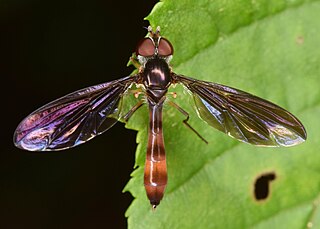
Hover flies of the genus Microdon are unusual among the Diptera. Like other members of the subfamily, they are myrmecophiles, meaning they inhabit the nests of ants.

Eristalinus taeniops is a species of hoverfly, also known as the band-eyed drone fly.

Xylota is a Holarctic genus of hoverflies similar in structure to the related genera Chalcosyrphus and Brachypalpoides. As the larvae are saprophytic they're usually found in rotting wood. The adult flies are generally associated with woodland and woodland edges and can often be seen running over the upper sides of leaves. Unlike other syrphids the adults of many species rarely visit flowers preferring instead to gather pollen from leaf surfaces. There are over 100 described species of which 12 can be found in Europe. Seven species have been recorded in Britain. Identification of species has been difficult and identifiction by photographs is risky.

Platycheirus is a large genus of hoverflies. They are also called sedgesitters.

Allograpta is a very large and diverse genus of hoverflies present throughout the world except most of the palearctic region. The adults are brightly coloured flower pollinators and most larvae have a predatory feeding mode involving soft-bodied sternorrhynchans. Certain species have diverged from this and their larvae have been found to be leaf-miners, stem-borers or pollen-feeders.

Toxomerus is a very large genus of hoverflies. They are found in many parts of North and South America. Most larvae are predators on soft bodied insects, though a few species have been shown to feed on pollen. Adults feed on the pollen of a wide range of flowers.

Brachyopa is a Holarctic genus of hoverflies whose grey and brown colouration is unusual for this family and these flies can easily be overlooked amongst members of other fly families. The larvae can be found under the bark of dead branches and trees in decaying sap.

Lejops is a genus of hoverflies, closely related to the genera Helophilus, Quichuana and Mallota.
Aristosyrphus is a genus of Neotropical hoverflies.
Carreramyia is a genus of hoverflies, with five known species currently.
Ceriomicrodon is a genus of hoverflies. The only known species, Ceriomicrodon petiolatus, lives in the Brazilian states Mato Grosso, Roraima, Amazonas, Maranhão and Rondônia. Its biology is poorly known, but the larvae are assumed to live in ant nests. Only a few specimens were known of the species until 2014, when the species was redescribed.
Chrysidimyia is a genus of hoverflies from Brazil, with only one known species, Chrysidimyia chrysidimima. The genus was described as a small metallic green fly with dense punctation that had an "astonishing resemblance" to chrysidid wasps.
Mixogaster is a genus of hoverflies native to North America and South America, with 21 known species. Mixogaster is distinct by lacking an appendix on vein R4+5, having a reduced and bare metasternum, an unarmed scutellum, and usually an appendix on vein M extending in cell R4+5. Larvae are found in ant nests.

Ornidia is a small genus of mid-sized metallic hoverflies.
Ubristes is a genus of hoverflies, with four known species. All are characterized by their metatibiae, which are usually enlarged, but always with a brush of long pile along the dorsal edges. These flies are probably mimics of the stingless bees in the tribe Meliponini.
Surimyia is a genus of hoverflies, with three known species. They are small microdontine flies. Surimyia is the only hoverfly genus with the katatergum lacking microtrichia. In the subfamily Microdontinae, they are distinctive in the absence of pilosity on the postpronotum.

Hypocritanus fascipennis is a species of syrphid fly in the family Syrphidae. Until 2020, it was classified in the genus Ocyptamus. The common name is the eastern band winged hover fly.
Domodon is a genus of hoverfly from South America and Central America containing five species.
Ornidia major is a species of Hoverfly in the family Syrphidae.









